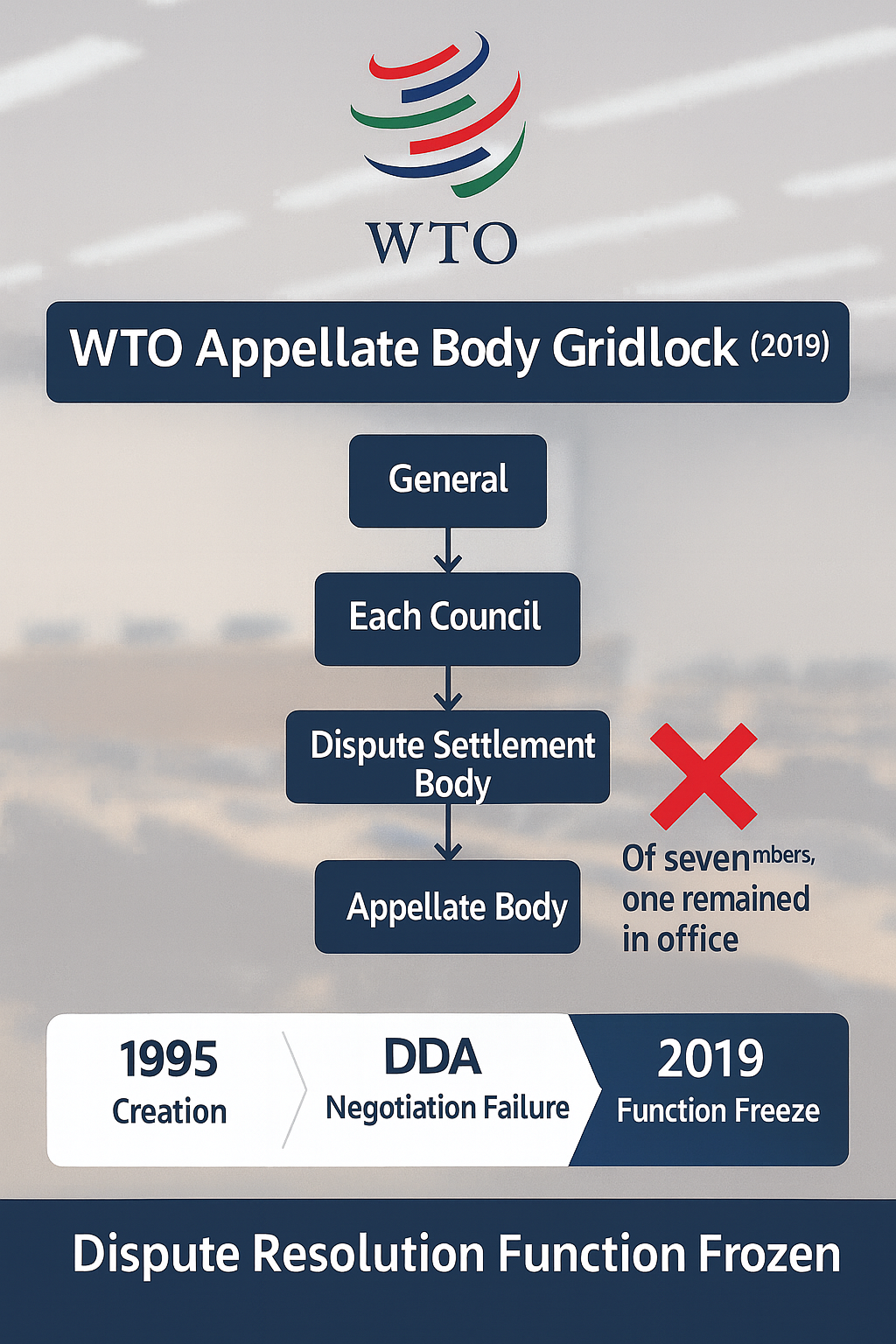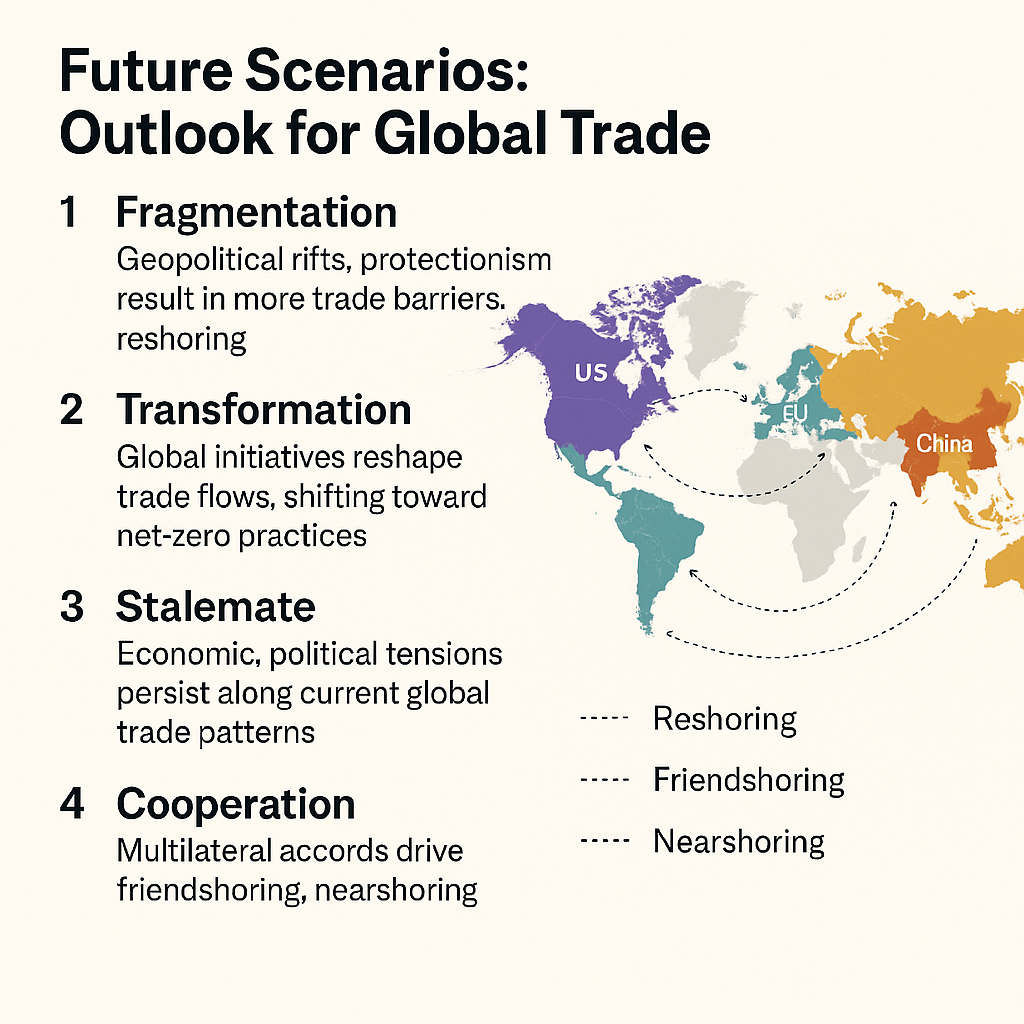WTO 체제의 종언, '트럼프 라운드'의 서막
글로벌 통상 지각변동 심층 분석
'자유무역'의 상징과도 같았던 세계무역기구(WTO) 체제가 역사의 뒤안길로 사라지고 있습니다. 그 자리에는 '미국 우선주의(America First)'를 기치로 내건 '트럼프 라운드'라는 새로운 질서가 거친 숨을 내쉬며 들어서고 있습니다. 다자간 협의와 규칙에 기반했던 과거의 시스템은 이제 강력한 힘의 논리와 양자 협상, 그리고 '관세'라는 무기를 앞세운 새로운 파도에 휩쓸리고 있습니다.
이번 포스팅에서는 격변하는 국제 통상 환경의 핵심, '트럼프 라운드'의 부상과 WTO 체제의 몰락을 심층적으로 분석하고, 이러한 변화가 글로벌 경제와 우리 삶에 미칠 파급 효과, 그리고 미래 시나리오를 전망해보고자 합니다.
1. 무엇이 WTO를 멈추게 했는가: 발생 배경 및 역사적 맥락
1995년 출범한 WTO 체제는 국가 간 무역 장벽을 낮추고, 분쟁을 예측 가능한 규칙에 따라 해결하며 세계 경제의 성장을 이끌었습니다. 하지만 도하개발아젠다(DDA) 협상의 실패, 그리고 '세계 무역의 대법원'이라 불리던 상소기구의 기능 마비가 결정타를 날렸습니다. 특히 트럼프 행정부 시절, 신규 위원 임명을 지속적으로 거부하며 2019년 말부터 상소기구는 사실상 기능이 정지되었습니다. 분쟁 해결이라는 가장 중요한 축이 무너지면서 WTO는 '종이호랑이'로 전락했습니다.

이러한 WTO의 내재적 한계는 보호무역주의가 고개를 들기 좋은 토양이 되었고, 2008년 글로벌 금융위기 이후 각국이 자국 산업 보호에 치중하는 경향 속에서 트럼프 1기 행정부의 등장은 이러한 흐름에 불을 붙인 기폭제가 되었습니다.
2. '트럼프 라운드'의 현실화: 현재 상황과 관련국 입장
'트럼프 라운드'는 미국의 강력한 통상 압박, 특히 고율 관세를 무기로 개별 국가와 양자 협상을 벌여 '미국에 유리한' 무역 질서를 재편하려는 움직임을 통칭하는 용어입니다.
- 미국: '미국 우선주의'를 최우선 가치로 삼고, 다자체제보다는 양자 협상을 통해 무역적자를 해소하고 자국 제조업을 부활시키는 것을 목표로 합니다.
- 중국: 미국의 가장 강력한 견제 대상이자 핵심 타깃으로, 보복 관세와 핵심 자원 통제 카드로 맞대응하며 독자적인 경제 블록 구축을 통해 장기전에 대비하고 있습니다.
- EU: 전통적인 다자주의 옹호자로서 미국의 일방주의에 비판적이지만, 협상의 끈을 놓지 않으며 '전략적 자율성'을 강조하고 역내 공급망을 강화하고 있습니다.
- 기타 국가 (일본, 인도 등): 미·중 갈등 속에서 실리를 추구하며 줄타기 외교를 펼치고 있습니다. CPTPP를 주도하거나, '차이나 플러스 원' 전략의 반사이익을 얻기 위해 노력하는 등 각자의 생존 전략을 모색 중입니다.
3. 예측 불가능의 시대: 글로벌 경제 파급 효과
'트럼프 라운드'는 글로벌 경제 전반에 거대한 불확실성을 드리우고 있습니다. 첫째, '효율성'보다 '안정성'이 중요해지면서 글로벌 공급망의 대대적인 재편이 가속화되고 있습니다. 둘째, 자동차와 반도체 등 특정 산업은 기술 패권 경쟁의 핵심으로 부상하며 직격탄을 맞고 있습니다. 셋째, 고율 관세와 공급망 재편 비용은 전 세계적인 물가 상승(인플레이션) 압력을 높이는 주된 요인으로 작용합니다.
4. 다가올 미래: 향후 시나리오와 전문가 전망
전문가들은 향후 국제 통상 질서가 몇 가지 시나리오를 따라 전개될 것으로 예측합니다.
- 시나리오 1: 각자도생의 심화와 블록 경제화 (가장 유력): 미국, 중국, EU를 중심으로 한 경제 블록화가 뚜렷해지며 블록 간 무역 마찰이 빈번해질 것입니다.
- 시나리오 2: 제한적 다자주의의 부활 (WTO 2.0): 무분별한 보호무역의 부작용을 완화하기 위해 디지털세, 환경 등 특정 이슈에 한해 새로운 형태의 다자간 협의체가 구성될 수 있습니다.
- 시나리오 3: '강대강' 대치와 글로벌 무역전쟁의 격화 (최악): 미·중 갈등이 전면적인 무역전쟁으로 번지며 세계 경제가 깊은 침체에 빠지는 경우입니다.

결론: 새로운 파도에 맞서는 지혜가 필요하다
분명한 것은, 우리가 알던 시대는 끝났다는 사실입니다. WTO로 대표되던 안정적이고 예측 가능했던 다자 무역의 시대는 저물고, 힘의 논리가 지배하는 '트럼프 라운드'의 거친 파도가 밀려오고 있습니다. 이제 특정 국가에 대한 과도한 의존도를 줄이고 수출입을 다변화하며, 초격차 기술력을 확보하고, 변화하는 통상 규범에 선제적으로 대응하는 전략적 유연성이 국가와 기업의 생존을 좌우할 것입니다. 새로운 질서는 이미 시작되었습니다.
Q&A: 독자의 이해를 돕는 질문들
Q1: '트럼프 라운드'가 정확히 무엇인가요?
A1: 공식적인 무역 협상은 아닙니다. 미국의 도널드 트럼프 행정부가 주도하는, '미국 우선주의'에 입각한 새로운 무역 질서 재편 움직임을 의미합니다. 다자 협상 대신 고율 관세를 무기로 개별 국가와 양자 협상을 벌여 미국에 유리한 결과를 이끌어내는 것이 특징입니다.
Q2: WTO는 이제 완전히 쓸모없어진 건가요?
A2: 분쟁 해결 기능과 새로운 규범 형성 기능이 마비되면서 영향력이 크게 약화된 것은 사실입니다. 하지만 기존 협정의 관리, 무역 통계 제공 등 기본적인 기능은 여전히 수행하고 있습니다. 많은 국가들이 WTO 개혁의 필요성을 주장하고 있어, 미래에 축소된 역할로나마 새로운 형태로 진화할 가능성도 있습니다.
Q3: 이러한 변화가 우리 실생활에는 어떤 영향을 미치나요?
A3: 수입 자동차, 전자제품 등 해외 상품들의 가격이 전반적으로 오를 수 있습니다. 국내 기업들의 수출 환경이 불안정해지면서 일자리와 투자에도 영향을 미칠 수 있으며, 환율이나 주식 시장의 변동성도 커질 수 있습니다.


- #트럼프라운드
- #WTO
- #세계무역기구
- #보호무역주의
- #미국우선주의
- #미중무역분쟁
- #글로벌공급망
- #국제통상
- #관세전쟁
- #경제블록화
Click to view the English version
The End of the WTO System, The Dawn of the 'Trump Round'
An In-depth Analysis of the Global Trade Tsunami
The World Trade Organization (WTO) system, once a symbol of 'free trade,' is fading into the annals of history. In its place, a new order, the 'Trump Round,' driven by the banner of 'America First,' is emerging with a forceful presence. The old system, based on multilateral consensus and rules, is now being swept away by a new wave dominated by the logic of power, bilateral negotiations, and the weaponization of 'tariffs.' This post will provide an in-depth analysis of the rise of the 'Trump Round' and the decline of the WTO system, which lie at the heart of the turbulent international trade environment. We will explore the ripple effects of these changes on the global economy and our daily lives, and forecast future scenarios.
1. What Brought the WTO to a Halt?: Background and Historical Context
Launched in 1995, the WTO system spurred global economic growth by lowering trade barriers. However, the failure of the Doha Development Agenda (DDA) negotiations and the paralysis of the Appellate Body, the 'Supreme Court of world trade,' delivered a final blow. The U.S., particularly during the Trump administration, consistently blocked the appointment of new members, effectively halting the dispute settlement mechanism from late 2019. With its most crucial pillar crumbled, the WTO was criticized as a 'paper tiger'.
This internal dysfunction created fertile ground for protectionism, a trend accelerated by the 2008 financial crisis and ignited by the first Trump administration.
2. The 'Trump Round' Becomes Reality: Current Situation and Stances
The 'Trump Round' refers to U.S.-led efforts to reshape the trade order to its advantage through aggressive bilateral negotiations backed by the threat of high tariffs.
- United States: Prioritizes 'America First,' using bilateral deals to reduce trade deficits and revive domestic manufacturing.
- China: The primary target, retaliating with tariffs and building its own economic bloc (e.g., RCEP, Belt and Road) for the long haul.
- European Union: Critical of U.S. unilateralism, it responds with retaliatory tariffs while pursuing 'strategic autonomy' and strengthening internal supply chains.
- Other Nations (Japan, India, etc.): Engaging in pragmatic diplomacy to navigate the U.S.-China conflict, leading initiatives like the CPTPP or attracting investment via the 'China Plus One' strategy.
3. The Age of Unpredictability: Ripple Effects on the Global Economy
The 'Trump Round' casts a shadow of uncertainty over the global economy. First, it accelerates a major reorganization of global supply chains, prioritizing 'stability' over 'efficiency.' Second, key industries like automobiles and semiconductors are at the center of a new tech-hegemony race. Third, high tariffs and supply chain restructuring costs are the main drivers of rising global inflation.
4. The Future Ahead: Scenarios and Expert Outlook
Experts predict several potential scenarios for the future of international trade.
- Scenario 1: Deepening 'Fend-for-Yourself' and Economic Blocs (Most Likely): Economic blocs centered around the U.S., China, and the EU will become more pronounced, leading to frequent trade friction.
- Scenario 2: Revival of Limited Multilateralism (WTO 2.0): New multilateral bodies may form to address specific issues like digital taxes or the environment to mitigate the side effects of protectionism.
- Scenario 3: 'Hard-line' Confrontation and Global Trade War (Worst-Case): An all-out trade war between the U.S. and China could trigger a deep global recession.
Conclusion: Wisdom is Needed to Face the New Wave
The era of stable, predictable multilateral trade is over, replaced by the rough waves of the 'Trump Round.' This change is both a crisis and an opportunity. Diversifying trade partners, securing technological leadership, and strategically adapting to new trade norms will be key to survival for nations and corporations alike. The new order has already begun.
Q&A for Reader Comprehension
Q1: What exactly is the 'Trump Round'?
A1: It's not a formal negotiation. It refers to the U.S.-led movement to reshape the trade order based on 'America First,' using high tariffs as leverage in bilateral negotiations to secure favorable outcomes for the United States.
Q2: Is the WTO completely useless now?
A2: While its dispute settlement and norm-setting functions are paralyzed, it still manages existing agreements and provides trade data. Many countries are calling for reform, so it may evolve into a new form with a more limited role.
Q3: How do these changes affect our daily lives?
A3: Prices for imported goods like cars and electronics may rise. An unstable export environment can affect jobs and investment, and increased global economic uncertainty can lead to higher volatility in currency and stock markets.
- #TrumpRound
- #WTO
- #WorldTradeOrganization
- #Protectionism
- #AmericaFirst
- #USTradeWar
- #GlobalSupplyChain
- #InternationalTrade
- #TariffWar
- #EconomicBlocs



